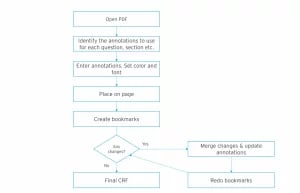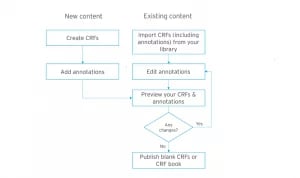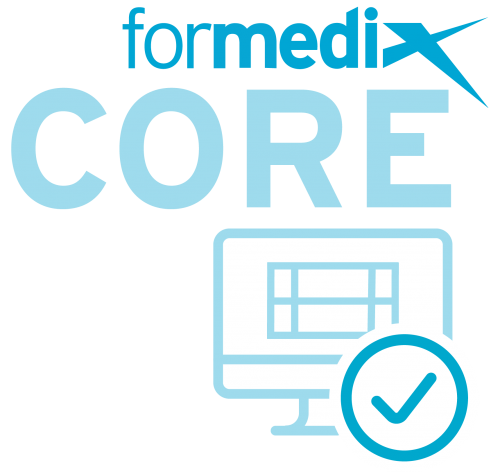What’s the deal with annotated CRFs?
To put it simply, annotated CRFs document the location in a database of the data collected for each question on a form.
Or put another way, it’s a mapping between each item on a form to its corresponding variable contained within the corresponding dataset.
Annotated CRFs are part of the mandatory CDISC submission deliverables to the FDA. So they’re a must!
They provide traceability. They help FDA reviewers find the origin of variables in the submitted datasets. And nothing should be left out.
There’s a huge amount of data to be dealt with across the whole industry. So it’s also really important to make sure all data submitted is standardized and consistent.
The traditional process
It’s common to annotate CRFs by hand in the pharmaceutical industry. As any Clinical Dataset Administrator will tell you, it’s a monotonous, time consuming manual task. And you need to keep doing it time and time again for every CRF, in every study.
Here’s an example of what a traditional process could be…

The first step is to open the PDF document. For each CRF, you have to identify all annotations that need to be added. And make sure you think about the many sources of data you have!
You need to set the font and color of your annotations. Then place them on the page, one by one.
Add all the links and bookmarks to each CRF. Because there’s so many, it’s difficult to create consistent annotations. And there’s no inheritance whatsoever!
When changes occur, which is likely, merge the changes and update the annotations. Then, you need to redo all your bookmarks.
It’s very likely there will be changes. If there are, they all need to be merged into the PDF document and the annotations updated. Then, all the bookmarks need to be redone.
And what if there are several rounds of changes? You can see why it’s such a time consuming, monotonous process…
So what’s the solution?… Automation!
What are the benefits of automating annotated CRFs?
In a nutshell:
- Manual work and effort are reduced – and boredom alleviated!
- It’s much quicker and easier to do than a manual process.
- You get higher quality, more consistent annotations.
- You can set up a format so that the color, position, and text is consistent.
- You can reuse your standardized annotations across different studies.
- It’s easy to edit forms and annotations.
- There’s no need to redo bookmarks – this is done automatically!
How can Formedix clinical trial automation software help?
By massively reducing the amount of effort and time spent. And you’ll have a much happier and more productive Clinical Dataset Administrator!
Formedix makes creating annotated CRFs easy. There’s no programming involved. Once you’ve got your forms and annotations, its 1 click to get your submission ready annotated CRF’s. You can read our blog on How clinical trial software can be used to optimize clinical trials to find out more about automation.
You can create your forms from scratch and add annotations. Or use your standards – you create them once and reuse again and again!
By standardizing forms you can be confident they’re aligned with your downstream datasets. And you know your annotations will be consistent and high quality because they’ve been standardized.
Need to edit your forms and annotations? It’s quick and easy to do! And you can preview them immediately to see how your changes look.
There’s no repetitive, time-consuming work! A few straightforward steps and you’re good to go.
How to do annotated CRF’s with Formedix

What if your content is new? Well, the only difference is that you need to create your forms and enter your annotations. This is straightforward to do, but it does take longer than using standardized, existing content. Then, just preview your forms and make any changes. With just one click of a button, publish your instant annotated CRFs.
And for existing content? Just import forms into your study along with your metadata assets such as edit checks and datasets. This includes your annotations. With the click of a button, you can preview your forms to make sure they look right.
When you’re happy, it’s literally a push of a button to generate your SDTM compliant instant annotated CRFs.
If you’re interested you can read our blog post on Everything you want to know about CRFs.
Want to find out more?
You can request a no-strings demo. Or, if annotations are giving you grief, tell us about it. We’ll let you know how we can help. All you have to do is contact us and tell us about what you want to achieve.
Do you want a helping hand?
Our Professional Services team is here to support you. You can get hold of them by phone, email, chat, or social media. Or, if it’s training you’re after to get up to speed with Formedix, or CDISC standards, we can help with that too!
![]()
About the author

Gilbert Hunter
Customer Success Manager | Formedix
Gilbert joined Formedix nearly ten years ago as a technical writer. The system knowledge he gained from content development, together with his existing customer service skills, marked him out for transition to the Professional Services (PS) team.
Gilbert has worked with the PS team for over four years, providing both CDISC-based training and software training, as well as support and consultancy services to Pharmaceutical, Biotechnology and Clinical Research Organizations. He helps organizations build studies faster and to a higher quality by making their clinical trial design and regulatory submissions far more efficient.
Today, as Customer Success Manager, Gilbert’s focus is to ensure customers maximize the benefits they can achieve from ryze by overcoming their challenges and achieving their goals.









